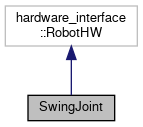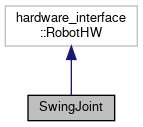This Packages the HallSensor class and Motor class together into a Hardware Interface. More...
#include <swing_joint.h>


Public Member Functions | |
| SwingJoint (const std::string &joint_name, const std::string &spi_device, uint8_t spi_cs_id, uint8_t spi_mode, uint8_t spi_bits, uint32_t spi_speed, uint16_t spi_delay, const std::string &can_name, uint8_t can_id, double zero_point, double error_command_position, uint spi_error_treshold, uint16_t mux_sel_pin_1, uint16_t mux_sel_pin_2, double joint_min_pos, double joint_max_pos) | |
| Constructor of the SwingJoint class. More... | |
| ~SwingJoint () | |
| destructor of SwingJoint class | |
| void | read () |
| Reads the Angle of the HallSensor and weighs errors of read. More... | |
| void | write () |
| Writes a command position to the motors. | |
| void | calibrate () |
| Sets the zero angle of the hallsensor using an internal function | |
| uint | getErrorState () |
| Returns true if the sensor is in ERROR state, false otherwise. More... | |
Detailed Description
This Packages the HallSensor class and Motor class together into a Hardware Interface.
The class offers two types of interfaces, a joint state interface which reads the joint position from the HallSensor class and a effort interface with which feedback controllers can controll the torque of the robot. More information on hardware interfaces can be found here. It also offers a calibration function which calls the setZero method of the HallSensor. This is done to allow calibration via ROS services. Lastly it contains a function for reading out how many errors in a row the last read accesses had.
Constructor & Destructor Documentation
◆ SwingJoint()
| SwingJoint::SwingJoint | ( | const std::string & | joint_name, |
| const std::string & | spi_device, | ||
| uint8_t | spi_cs_id, | ||
| uint8_t | spi_mode, | ||
| uint8_t | spi_bits, | ||
| uint32_t | spi_speed, | ||
| uint16_t | spi_delay, | ||
| const std::string & | can_name, | ||
| uint8_t | can_id, | ||
| double | zero_point, | ||
| double | error_command_position, | ||
| uint | spi_error_treshold, | ||
| uint16_t | mux_sel_pin_1, | ||
| uint16_t | mux_sel_pin_2, | ||
| double | joint_min_pos, | ||
| double | joint_max_pos | ||
| ) |
Constructor of the SwingJoint class.
double upper joint limit
- Parameters
-
joint_name string joint name spi_device string file descriptor of spi device spi_cs_id uint8_t id of sensor on multiplexer spi_mode uint8_t mode of spi transfer: clock phase & polarity spi_bits uint8_t spi bits per word spi_speed uint32_t spi transfer speed in Hz spi_delay uint16_t delay in usec after last bit transfer, before device deselect. can_name string can name can_id uint8_t can id zero_point double zero angle offset for sensor error_command_position double default motor position (current) if errors occur spi_error_treshold uint upper limit for accumulated errors, till ERROR state is reached mux_sel_pin_1 uint16_t 1st selector pin for multiplexer mux_sel_pin_2 uint16_t 2nd selector pin for multiplexer joint_min_pos double lower joint limit
Member Function Documentation
◆ getErrorState()
| uint SwingJoint::getErrorState | ( | ) |
Returns true if the sensor is in ERROR state, false otherwise.
Checks if the weighted sum of errors is greater than the error threshold.
◆ read()
| void SwingJoint::read | ( | ) |
Reads the Angle of the HallSensor and weighs errors of read.
This function sets internal position variable for controller. It also reads the errors of the read access, and calculates a weighted sum of them. The sum dictates, whether the joint is in ERROR state, which is reached if: sum > spi_error_treshold
The documentation for this class was generated from the following files:
- swing_joint.h
- swing_joint.cpp